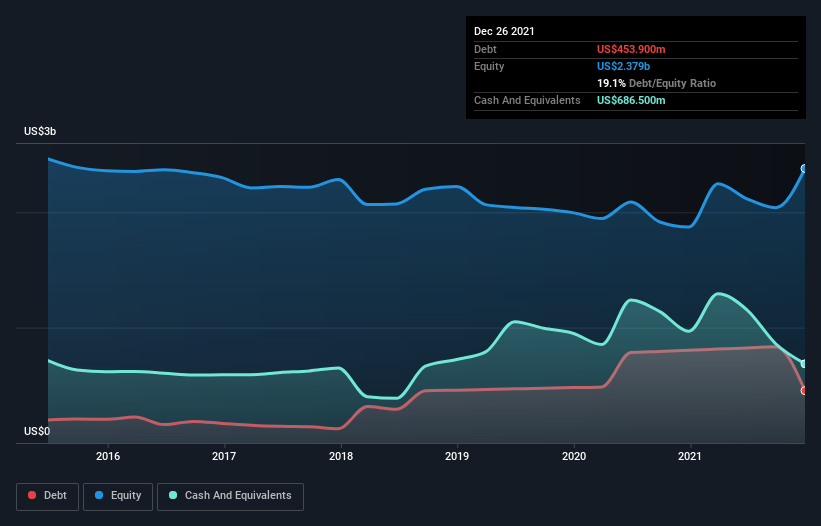Is Wolfspeed (NYSE:WOLF) Using Too Much Debt?
Howard Marks put it nicely when he said that, rather than worrying about share price volatility, 'The possibility of permanent loss is the risk I worry about... and every practical investor I know worries about.' So it might be obvious that you need to consider debt, when you think about how risky any given stock is, because too much debt can sink a company. As with many other companies Wolfspeed, Inc. (NYSE:WOLF) makes use of debt. But the real question is whether this debt is making the company risky.
What Risk Does Debt Bring?
Debt assists a business until the business has trouble paying it off, either with new capital or with free cash flow. Part and parcel of capitalism is the process of 'creative destruction' where failed businesses are mercilessly liquidated by their bankers. However, a more usual (but still expensive) situation is where a company must dilute shareholders at a cheap share price simply to get debt under control. Of course, the upside of debt is that it often represents cheap capital, especially when it replaces dilution in a company with the ability to reinvest at high rates of return. The first step when considering a company's debt levels is to consider its cash and debt together.
Check out our latest analysis for Wolfspeed
What Is Wolfspeed's Debt?
As you can see below, Wolfspeed had US$453.9m of debt at December 2021, down from US$803.5m a year prior. But on the other hand it also has US$686.5m in cash, leading to a US$232.6m net cash position.
How Strong Is Wolfspeed's Balance Sheet?
We can see from the most recent balance sheet that Wolfspeed had liabilities of US$341.0m falling due within a year, and liabilities of US$497.0m due beyond that. On the other hand, it had cash of US$686.5m and US$220.5m worth of receivables due within a year. So it can boast US$69.0m more liquid assets than total liabilities.
Having regard to Wolfspeed's size, it seems that its liquid assets are well balanced with its total liabilities. So it's very unlikely that the US$14.2b company is short on cash, but still worth keeping an eye on the balance sheet. Simply put, the fact that Wolfspeed has more cash than debt is arguably a good indication that it can manage its debt safely. The balance sheet is clearly the area to focus on when you are analysing debt. But it is future earnings, more than anything, that will determine Wolfspeed's ability to maintain a healthy balance sheet going forward. So if you're focused on the future you can check out this free report showing analyst profit forecasts.
Over 12 months, Wolfspeed reported revenue of US$613m, which is a gain of 32%, although it did not report any earnings before interest and tax. Shareholders probably have their fingers crossed that it can grow its way to profits.
So How Risky Is Wolfspeed?
We have no doubt that loss making companies are, in general, riskier than profitable ones. And in the last year Wolfspeed had an earnings before interest and tax (EBIT) loss, truth be told. Indeed, in that time it burnt through US$916m of cash and made a loss of US$378m. But the saving grace is the US$232.6m on the balance sheet. That kitty means the company can keep spending for growth for at least two years, at current rates. With very solid revenue growth in the last year, Wolfspeed may be on a path to profitability. By investing before those profits, shareholders take on more risk in the hope of bigger rewards. The balance sheet is clearly the area to focus on when you are analysing debt. But ultimately, every company can contain risks that exist outside of the balance sheet. For example - Wolfspeed has 2 warning signs we think you should be aware of.
If you're interested in investing in businesses that can grow profits without the burden of debt, then check out this free list of growing businesses that have net cash on the balance sheet.
Have feedback on this article? Concerned about the content? Get in touch with us directly. Alternatively, email editorial-team (at) simplywallst.com.
This article by Simply Wall St is general in nature. We provide commentary based on historical data and analyst forecasts only using an unbiased methodology and our articles are not intended to be financial advice. It does not constitute a recommendation to buy or sell any stock, and does not take account of your objectives, or your financial situation. We aim to bring you long-term focused analysis driven by fundamental data. Note that our analysis may not factor in the latest price-sensitive company announcements or qualitative material. Simply Wall St has no position in any stocks mentioned.

